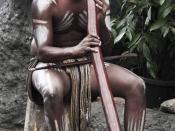In early colonial art the aboriginals were portrayed as a 'noble savage'.
Clad in old rags to hide their nakedness from the eyes of the Europeans the Aboriginals became, during the 1820s and 1830s, the butt of a cruel and insensitive colonial humour. The colonial artists drew Aboriginal people with large odd shaped mouths and big lips portraying them as some kind of deformed animal.
For the great majority of the colonists the Aboriginals represented the lowest condition of human existence. Contact with Europeans debauched their simple tribal structure and shattered the economic basis of their existence.
The conflict between Europeans and the Aboriginals can be seen in the second picture. At first the Aborigines tolerated the settlers and sometimes welcomed them, but when it became apparent that they and their livestock had come to stay, competition for access to the land developed, and friction between the two ways of life became inevitable.
The photo shows Aboriginal people being taken to court for trespassing, but what is trespassing to the Aboriginals, they where free to go anywhere they liked before the Europeans arrived.
This Automatically contributed to conflict because the Aboriginal people came to realise that they weren't allowed to go about there everyday life as they have been doing for hundreds of years, but now they had to obey by the white mans law.
Europeans considered Aboriginals to be no good drunks that could not make anything of there life. From the picture titled 'Alcohol Abuse', you can see that the artist has drawn them drinking and fighting. From this people are given the impression that all Aboriginal people are like this. But if you look at the picture drawn by the Aboriginal person, you can clearly see a different way of life. He has drawn a picture...


